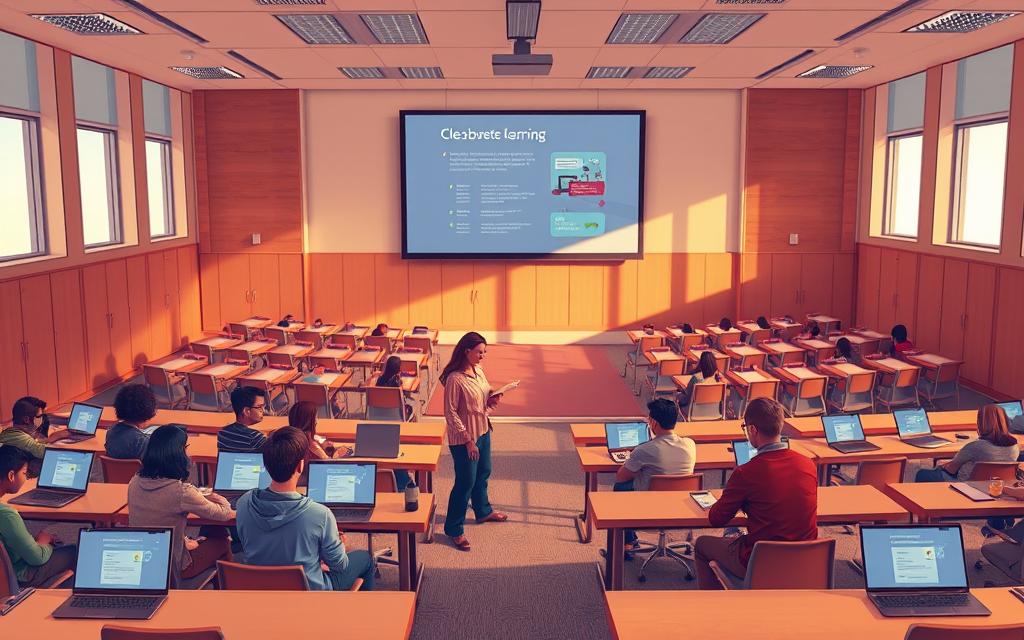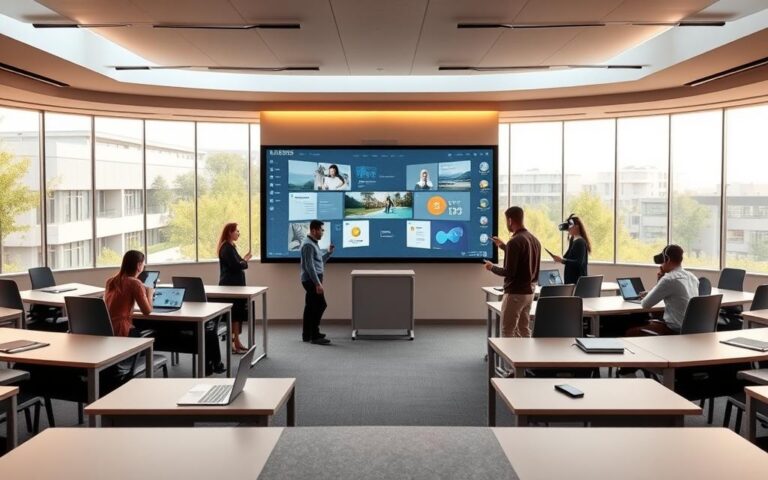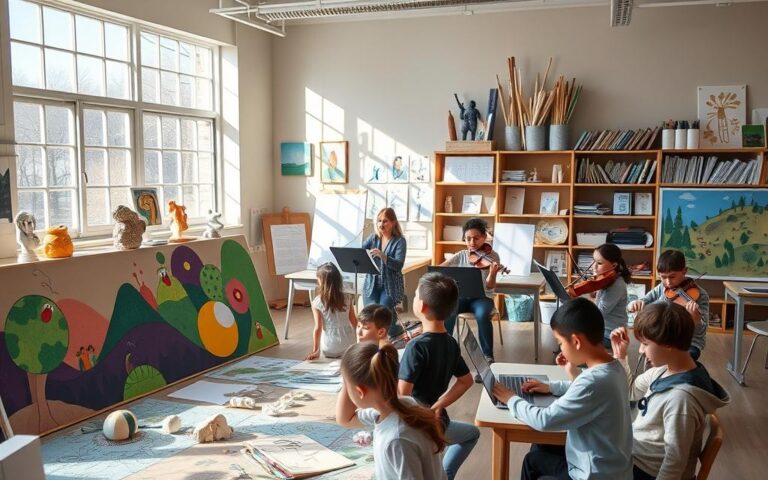Hybrid learning is changing how teachers plan lessons and how schools design spaces. Since 2020, there’s been a big jump in blended learning models. Schools are now using platforms like Canvas and Blackboard more than ever.
Today’s classrooms are a mix of in-person and online learning. This mix helps students manage school, work, and home life better. It also lets teachers tailor lessons and track student progress more easily.
This article is for administrators, teachers, parents, and policymakers. It explains the changes in hybrid learning. You’ll learn about technology’s role, the benefits and challenges, and how it works in schools. Plus, you’ll find tools to help create strong hybrid programs.
What is Hybrid Learning?
Hybrid learning combines in-person teaching with online learning. It offers a flexible classroom experience. Students move between a physical room and a virtual classroom smoothly.
Hybrid learning is different from online and traditional classrooms. Schools mix live sessions with digital work. Students might watch a video, then do a project in class.
Definition and Overview
There are many types of hybrid learning. Rotation models use online and in-person activities. Flipped classrooms start with web content, then practice in class.
Flex models focus on online learning with occasional in-person help. Enriched virtual models add labs or assessments in person. This mix supports different learning styles.
Synchronous tools, like live video, offer real-time interaction. Asynchronous tools, like recorded lectures, let students learn at their own pace. This supports various learning styles and keeps learning continuous.
Key Features of Hybrid Learning
Flexibility is key. Students can access courses anytime through a learning management system. This helps them balance school with other activities.
Personalization is important. Adaptive software and analytics adjust learning to fit each student. Teachers use data to help students who need it.
Technology is crucial. Virtual classroom platforms and video conferencing tools connect everyone. Schools design classrooms for good audio and video.
Assessment combines digital checks with in-person tasks. This helps students improve and lets teachers adjust lessons. Feedback loops are important for continuous improvement.
Success depends on good planning. Schools need to balance online and in-person time. Clear rules and good technology support are also key.
The Evolution of Hybrid Learning
The move from mail to online classes has been slow but significant. In the 19th century, distance learning started with mail courses. Then, in the 20th century, TV classes became common.
As the internet grew, teachers began mixing face-to-face lessons with online tools.
By the early 2000s, blended learning became popular. Schools and colleges started using online systems to share materials and track student progress. Over the 2010s, many programs shifted from just supplementing classroom teaching to fully blended models.
Historical Context
Correspondence courses laid the groundwork for remote learning. TV classes made lectures more accessible. The rise of fast internet and tools like Moodle and Blackboard made sharing courses easier.
The term blended learning became common as teachers combined online and classroom teaching. Early trials showed that mixing methods improved scheduling and resource use.
The Role of Technology
Systems like Canvas and Blackboard helped manage courses, grades, and data. Tools like Zoom and Microsoft Teams enabled live chats between teachers and students.
With mobile devices and Google Workspace, learning became accessible anywhere. Platforms like Khan Academy and DreamBox offered personalized practice. Tools like Nearpod and Pear Deck made lessons interactive.
Analytics started to warn about students who were falling behind. AI began suggesting content and pacing. These tools helped make distance learning more effective in hybrid setups.
| Era | Key Technology | Impact on Learning |
|---|---|---|
| Late 1800s–1950s | Correspondence, Radio, TV | Expanded access to education beyond campuses |
| 1990s–2005 | Early LMS, Broadband | Enabled course materials online and basic tracking |
| 2006–2015 | Advanced LMS, Video Conferencing | Blended learning model gains traction; hybrid programs emerge |
| 2016–Present | Adaptive Platforms, Cloud Services, AI | Personalized pathways and real-time analytics in digital education |
Benefits of Hybrid Learning
Hybrid learning mixes classroom time with online study. It opens new paths for student success. Schools in the United States use it to make learning more accessible and effective.
This approach combines face-to-face teaching with digital tools. It offers flexible and personalized learning experiences. Each student can learn at their own pace.
Flexibility for Students
Students can manage their time better with hybrid learning. It works well for those with jobs, sports, or long commutes. They can review material online at their own pace.
It also lets students access more courses than their local school offers. They can take advanced classes from other schools or universities. This helps them explore different interests and career paths.
Personalized Learning Experience
Adaptive platforms adjust content to fit each student’s needs. Learning management systems help teachers tailor lessons. This way, students get the right support at the right time.
Personalized learning lets students take charge of their learning. They choose what to do and when. Teachers guide them with clear goals and feedback. This helps students become more independent while staying supported.
Research shows hybrid learning can improve student engagement and achievement. The key is strong instructional design, teacher training, and reliable digital tools.
Challenges of Implementing Hybrid Learning
Hybrid learning offers new ways to learn but also brings challenges. Schools face practical issues that affect daily lessons and long-term plans. These issues arise from mixing virtual and in-person learning.
Technical Difficulties
Not everyone has equal access to devices and internet. This digital divide makes it hard for all students to participate equally. Students in rural or low-income areas often lack reliable internet or quiet places to study.
Technical issues like camera or microphone failures can also disrupt lessons. Schools need to budget for devices, repairs, and strong networks to keep classes going smoothly.
Keeping student data safe is also crucial. Schools must protect student records and secure video sessions. This requires investing in trusted platforms and training staff to build parent trust.
Having a strong IT team is key. Districts need to spend on network upgrades and maintenance. Without quick tech help, teachers spend too much time fixing problems instead of teaching.
Engagement Issues
It’s hard to keep all students engaged, whether they’re learning remotely or in person. Remote students might feel left out while in-person students dominate. Teachers need to find ways to make sure everyone participates.
Video makes it harder for teachers to read students’ nonverbal cues. This can make it tough to know if students understand or to adjust the lesson. It affects the quality of learning for both groups.
Teachers often work harder in hybrid learning. They plan lessons for both groups, grade different formats, and create engaging online content. Schools need to give teachers time to plan and collaborate to avoid burnout.
It’s important to make sure all students have a chance to participate. Remote students should be able to ask questions, lead discussions, and join hands-on activities. Schools need to have clear rules to make sure everyone has a voice in the hybrid classroom.
Hybrid Learning in K-12 Education
K-12 teachers are now designing lessons differently. They mix online tasks with face-to-face activities. This helps students learn in ways that suit them best and keeps them connected to school.
Teachers use smart strategies to make online and offline learning smooth. Small changes in scheduling or technology can make a big difference. Schools see better results when staff and families work together closely.
Innovative Teaching Strategies
The flipped classroom model is becoming popular. It involves watching videos or doing online modules at home. Then, students practice in class.
Station rotation is another strategy. It lets students move between different activities. Tools like Google Classroom and Seesaw help manage these rotations.
Project-based learning connects real-world tasks with online tools. Google Workspace and Seesaw help teams work together, both online and in class.
Teachers use digital assessments to check student progress quickly. These assessments help teachers adjust lessons on the fly.
Universal Design for Learning (UDL) guides lesson planning. It helps all students, including English learners and those with disabilities, access content in both online and offline settings.
Success Stories from Schools
In New York City, some schools saw better attendance and fewer failures. They added tutoring, outreach, and tech support.
Charter networks and public schools using Seesaw, ClassDojo, and Google Classroom report stronger parent-teacher connections. Digital portfolios on these tools help families see how their children are doing.
Many middle and high schools improved engagement by offering both live tutoring and online practice. This approach gave students feedback and helped close learning gaps.
When schools use a blended learning model with clear routines, teacher support, and student help, they see better results. Good design, reliable technology, and ongoing training help diverse learners succeed.
Higher Education and Hybrid Learning
Colleges and universities are moving towards hybrid learning. This combines digital tools with campus experiences. Teachers use systems like Blackboard and Canvas to mix online lectures with in-person labs.

Blended Course Models
Some courses have lectures online and labs or seminars on campus. HyFlex options let students choose how they attend each session. For STEM programs, virtual labs and simulations help with experiments when students learn from home.
Teachers create short learning modules, discussion forums, and peer review assignments to keep students engaged. They use strong LMS integrations and secure tools for exams. This shows a practical approach to blended learning in higher education.
Student Feedback and Outcomes
Many students like the flexibility of hybrid learning. They appreciate the balance it offers between work and school. Some say face-to-face time is still important for complex discussions.
Research shows well-designed hybrid courses can be just as good as traditional ones. Success depends on students’ digital skills, motivation, and access to help. Colleges that invest in training and support see better results.
Role of Educators in Hybrid Learning
Teachers play a key role in making hybrid learning work. They mix face-to-face teaching with online tools to keep students interested and supported. Good teacher training helps them create clear lessons, check student progress, and meet different learning needs.
Teacher Training and Development
Teachers need training on teaching online, making engaging content, and using classroom tech like Google Classroom and Canvas. They also get feedback from coaching and observing peers.
They can take self-paced courses from Coursera, edX, and ISTE workshops to earn certificates. This boosts their confidence. Training should also cover making digital education accessible to all students.
Teachers learn to use data to improve their teaching. They learn to read analytics and assessment data to find areas to improve and adjust their teaching.
Collaboration and Support Systems
Teachers join communities of practice to share ideas and resources. They use Slack and Microsoft Teams to work together and keep records.
Administrative support is crucial. Schools have tech specialists and IT help desks to help teachers focus on teaching. They also have time to update their courses.
Teachers work with librarians, counselors, and special education staff to support students. They also communicate with parents to keep them involved.
Technology Tools for Hybrid Learning
Hybrid classrooms need a variety of tools to work well for everyone. The right tools help teachers and students stay connected, whether they’re in the classroom or at home. They make sure learning is engaging and keep everyone’s data safe.
Learning platforms and course management
Systems like Canvas, Blackboard, Moodle, and Google Classroom are key. They hold all the course materials, run quizzes, and keep track of grades. Teachers can mix live lessons with online content, helping students learn at their own pace.
It’s important for these systems to work well together. Look for tools that are easy to use on phones and tablets. Also, make sure they follow strict privacy rules, which is crucial for schools and universities.
Live instruction and collaboration tools
Platforms like Zoom, Microsoft Teams, and Google Meet are essential for live lessons. They offer features like breakout rooms and polls to keep everyone involved. Teachers can also record sessions and add captions for better accessibility.
Good practices include setting rules for using cameras and microphones. Recordings help students in different time zones catch up. Moderating chat helps keep discussions on track. Use tools like Nearpod and Pear Deck to make sessions more interactive.
| Tool Type | Top Examples | Key Features | When to Use |
|---|---|---|---|
| Learning Management Systems | Canvas, Blackboard, Moodle, Google Classroom | Content hosting, gradebooks, analytics, quizzes, LTI integrations | Course organization, tracking progress, blended assessments |
| Video Conferencing Platforms | Zoom, Microsoft Teams, Google Meet | Breakout rooms, polling, recording, captions, attendance | Live instruction, office hours, synchronous discussions |
| Interactive Session Tools | Nearpod, Pear Deck, Jamboard | Real-time quizzes, draggable activities, collaborative whiteboards | Active learning during live sessions, formative checks |
| Assessment & Proctoring | Respondus, ProctorU, LockDown Browser | Secure tests, identity checks, lockdown features | High-stakes exams, academic integrity needs |
| Accessibility & Support | Otter.ai, Microsoft Immersive Reader | Transcripts, captions, text-to-speech, readability tools | Supporting diverse learners and compliance |
Choosing tools that work well together makes learning easier for everyone. When systems integrate smoothly, the virtual classroom feels natural. This setup encourages more interactive learning and keeps instruction flexible.
The Impact of COVID-19 on Hybrid Learning
The pandemic changed how schools and colleges teach. In 2020, schools quickly moved to remote learning. Teachers and administrators had to rethink how they teach.
Students moved between classrooms and screens. Districts worked hard to keep learning going.
Rapid Adoption of Hybrid Models
When buildings closed, schools turned to online tools. They used learning management systems and video platforms. This quick shift meant schools had to give out devices and offer internet access fast.
Grants helped buy Chromebooks and improve internet in rural areas. Colleges like Arizona State added online classes to meet the demand.
Long-term Changes in Education
Some changes are here to stay. Many districts created virtual academies and flexible learning options. Rules and policies were updated to include online learning as a choice.
Investments in technology and training grew. Schools now budget for online tools, security, and training. Policymakers focus on making sure all students have equal access to online learning.
Future Trends in Hybrid Learning
Classrooms are changing as schools mix in-person and online learning. Teachers and tech teams are setting up spaces for hands-on work and clear online streams. They use smart tools and new course designs to keep students engaged, whether they’re in class or at home.
Emerging Educational Technologies
Artificial intelligence will soon guide learning paths and offer quick feedback. Learning platforms like Blackboard and Canvas will use data to spot students who need help.
Virtual and augmented reality will open up new ways to explore labs and field trips. Schools will offer VR experiences for science and history, making learning feel real.
Micro-credentials and competency-based models will become more popular. Platforms like Coursera and Credly make it easy to earn short, valuable certificates.
Systems will work better together through APIs and data standards. This will speed up record-keeping and let teachers focus on teaching.
Predictions for Classroom Environments
Classrooms will have flexible furniture and top-notch audiovisual equipment. Schools will invest in better cameras and audio for remote learners to join in smoothly.
Curricula will focus on skills and be flexible for different learning styles. Lessons will teach teamwork, digital skills, and self-management for hybrid learning success.
Online and offline work will blend in a smarter way. Educators will create interactive courses that mix live sessions with pre-recorded units to meet various learning needs.
Accessibility will be a key feature in tools, with features like automatic captions and participation tools. This will make online learning fair for everyone.
How Parents Can Support Hybrid Learning
Parents are crucial in a hybrid school program that mixes learning at home and in class. Small steps at home can make school routines easier and boost kids’ confidence. Having clear routines, reliable tech, and calm spaces helps students do well in both live lessons and independent work.
Communication with educators
Start regular chats with teachers using tools like ClassDojo or Remind. Check the Learning Management System (LMS) weekly for updates. Ask for brief meetings to talk about routines, behavior, and any special needs.
When asking for your child, discuss the mix of live and online learning. Understand how grades are given and ask for extra help if needed. Clear, respectful messages help build trust and make working together easier.
Creating a conducive learning environment
Make a quiet, well-lit area for studying with a good device and internet. Post a daily schedule that matches school to avoid confusion. Encourage breaks and good posture to stay focused.
Teach kids how to use the LMS, submit work, and talk to teachers. Focus on study skills, managing time, and being safe online. If tech or internet is a problem, look into local library or district help.
When parents support hybrid learning, kids make better progress and feel safer. Good communication with teachers and a practical learning space make the hybrid program work for everyone.
Conclusion: The Future of Education
Hybrid learning has become a key part of education’s future. Schools and universities now mix online tools with classroom learning. This approach makes learning more accessible, personalized, and modern.
This change brings flexible learning options that meet different student needs. It also helps build resilient education systems.
Embracing the Changes
Hybrid models should be seen as a chance to redesign learning around students. Teachers can adjust lessons to fit each student’s needs. Administrators and tech providers can support these efforts with scalable platforms.
When schools invest in training and fair access to devices, hybrid learning improves outcomes and fairness.
The Importance of Adaptability
Adaptability is key: ongoing training, constant assessment, and data-driven tweaks are crucial. Everyone involved must work together on solutions that support well-being, learning goals, and access.
By focusing on student needs, we can make hybrid learning and flexible options work for everyone. This ensures education meets the needs of all students, now and in the future.



